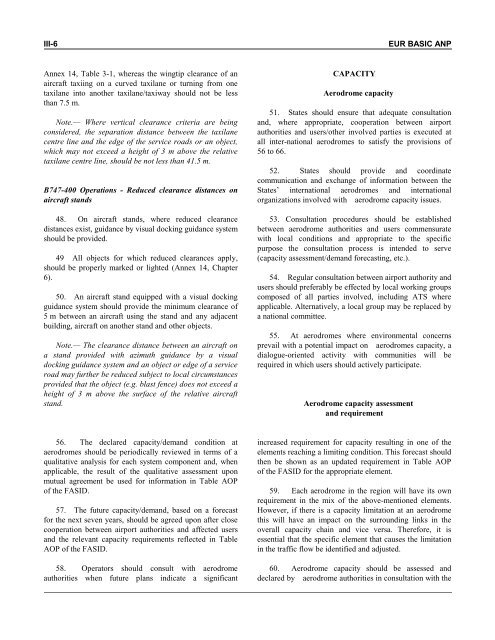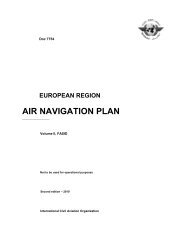7754 Vol 1 Flyleaf - ICAO Public Maps
7754 Vol 1 Flyleaf - ICAO Public Maps
7754 Vol 1 Flyleaf - ICAO Public Maps
You also want an ePaper? Increase the reach of your titles
YUMPU automatically turns print PDFs into web optimized ePapers that Google loves.
III-6 EUR BASIC ANP<br />
Annex 14, Table 3-1, whereas the wingtip clearance of an<br />
aircraft taxiing on a curved taxilane or turning from one<br />
taxilane into another taxilane/taxiway should not be less<br />
than 7.5 m.<br />
Note.— Where vertical clearance criteria are being<br />
considered, the separation distance between the taxilane<br />
centre line and the edge of the service roads or an object,<br />
which may not exceed a height of 3 m above the relative<br />
taxilane centre line, should be not less than 41.5 m.<br />
B747-400 Operations - Reduced clearance distances on<br />
aircraft stands<br />
48. On aircraft stands, where reduced clearance<br />
distances exist, guidance by visual docking guidance system<br />
should be provided.<br />
49 All objects for which reduced clearances apply,<br />
should be properly marked or lighted (Annex 14, Chapter<br />
6).<br />
50. An aircraft stand equipped with a visual docking<br />
guidance system should provide the minimum clearance of<br />
5 m between an aircraft using the stand and any adjacent<br />
building, aircraft on another stand and other objects.<br />
Note.— The clearance distance between an aircraft on<br />
a stand provided with azimuth guidance by a visual<br />
docking guidance system and an object or edge of a service<br />
road may further be reduced subject to local circumstances<br />
provided that the object (e.g. blast fence) does not exceed a<br />
height of 3 m above the surface of the relative aircraft<br />
stand.<br />
56. The declared capacity/demand condition at<br />
aerodromes should be periodically reviewed in terms of a<br />
qualitative analysis for each system component and, when<br />
applicable, the result of the qualitative assessment upon<br />
mutual agreement be used for information in Table AOP<br />
of the FASID.<br />
57. The future capacity/demand, based on a forecast<br />
for the next seven years, should be agreed upon after close<br />
cooperation between airport authorities and affected users<br />
and the relevant capacity requirements reflected in Table<br />
AOP of the FASID.<br />
58. Operators should consult with aerodrome<br />
authorities when future plans indicate a significant<br />
CAPACITY<br />
Aerodrome capacity<br />
51. States should ensure that adequate consultation<br />
and, where appropriate, cooperation between airport<br />
authorities and users/other involved parties is executed at<br />
all inter-national aerodromes to satisfy the provisions of<br />
56 to 66.<br />
52. States should provide and coordinate<br />
communication and exchange of information between the<br />
States’ international aerodromes and international<br />
organizations involved with aerodrome capacity issues.<br />
53. Consultation procedures should be established<br />
between aerodrome authorities and users commensurate<br />
with local conditions and appropriate to the specific<br />
purpose the consultation process is intended to serve<br />
(capacity assessment/demand forecasting, etc.).<br />
54. Regular consultation between airport authority and<br />
users should preferably be effected by local working groups<br />
composed of all parties involved, including ATS where<br />
applicable. Alternatively, a local group may be replaced by<br />
a national committee.<br />
55. At aerodromes where environmental concerns<br />
prevail with a potential impact on aerodromes capacity, a<br />
dialogue-oriented activity with communities will be<br />
required in which users should actively participate.<br />
Aerodrome capacity assessment<br />
and requirement<br />
increased requirement for capacity resulting in one of the<br />
elements reaching a limiting condition. This forecast should<br />
then be shown as an updated requirement in Table AOP<br />
of the FASID for the appropriate element.<br />
59. Each aerodrome in the region will have its own<br />
requirement in the mix of the above-mentioned elements.<br />
However, if there is a capacity limitation at an aerodrome<br />
this will have an impact on the surrounding links in the<br />
overall capacity chain and vice versa. Therefore, it is<br />
essential that the specific element that causes the limitation<br />
in the traffic flow be identified and adjusted.<br />
60. Aerodrome capacity should be assessed and<br />
declared by aerodrome authorities in consultation with the














